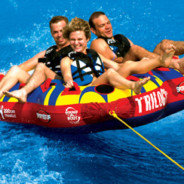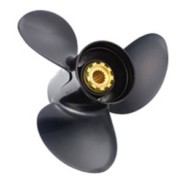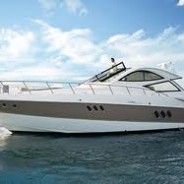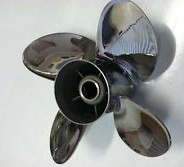Tips on Buying a Used Boat
If you are thinking of buying a used boat you should decide first what you want to use the boat for then what style of boat would best fit your needs. Do you have a family and want to just cruise around on inland lakes and maybee pull your kids on tubes and towables sometimes? Then you might want a 18 to 21 foot bowrider with a sterndrive propulsion systerm or maybee with an outboard motor. Do you want to go fishing most of the time by yourself or with a buddy or two, then a bass boat would work out good for you. A fish and ski style boat might be your choice if the whole family and friends want to go fishing.Do you have a need for speed? Then the low profile/ offshore racing style high horsepower boat would be the way to go. Do you want to go on the Great Lakes or out in the ocean? Then a bigger, sturdier boat should be your choice. A pontoon boat would be great for enjoying the water with family and friends. There are a lot choices out there and many styles of boats can be used in multible ways.
While you are figuring out what kind of boat you want and what size to get you also need to think about how much money you can spend on a boat. Can you afford to pay in full or should you take out a loan? Paying in full would be the best way but you could most likely get a better, more expensive boat if you take out a loan and pay over time just like a car. How do you know how much boats are worth? You can Google “used boat price guide” which will show you many good sources for prices. Craigslist is a great place to find boats for sale in your erea and also how much people are asking for them. What ever you do make sure to be honest with yourself about what you can afford to pay. Remember, boats are just big toys. Don’t let buying one put too much of a burden on you financialy or your dream boat could turn into a nightmare.
When you start looking around at boats condition and price is most important. Your goal should be to buy the newest, best looking, best running boat at the lowest price you can get. You should always test drive the boat in the water if you can. If you don’t, you are taking a big chance on if it is a good boat and a good deal. If the boat sides are all scratched up from bouncing up against a dock, fiberglass, wood or aluminum repair is needed to make the boat look good again. These repairs are not cheap so you might want to pass on that boat. If you want the boat and are willing to do pay for repairs make sure the price you pay takes this into account. Check out the bottom of the boat. Same thing applies. How is the interior, floor, fittings and all the other things about the boat? Check everything out. You do not want any surprises if you buy it. How does the engine sound and run? If you hear something you are not sure about or if you think it is not running right, have a marine engine mechanic check it out before you buy it. Even if everything seems ok to you, maybe you should have a mechanic look at it anyways. Is the boat prop alright? It needs to be pretty much in like new condition or it could cause damage to you drive system. If the blades are bent and/or missing material, minor or major vibration will occure which is not good for the drive and engine. If the boat propeller is bad, replace it or get it repaired.
Buying a used boat can be be tricky so educate yourself first, look at many boats if you can to compare different ones and be realistic about what you can afford. Good luck and I hope you really enjoy the boat you buy.
Boat Propeller Repair
Most boat propellers are repairable just so long as they are not too badly damaged and cost less than a new propeller. But they may not be repairable or they may be too costly to repair. Boat props are repairable if there is no more than about 20% of each blade missing. The repair shop can weld on new metal and shape it and make it look pretty close to the original blade configuration, but repairs are done by hand which means they are not going to be like new and they are not going to perform quite the same as a new propeller. But if the repair shop does a good job on the propeller it will work well enough for most people or at least be good for a spare prop.
Aluminum props are the least expensive and easiest propellers to repair. And you can get the pitch changed which might make your boat work a little better, either more speed or more power possibly but there are no guarantees on prop repairs or pitch changes. You can get the pitch changed 1″ either up or down on props with 14″ pitch or lower and 2″ change on props with 15″ pitch and higher. You can also get cupping of the blades added or taken out that might improve performance. You can get this done all props, not just aluminum ones.
Stainless steel, bronze and nibral propellers are more expensive to repair and they also usually do not perform like a new prop. You can get the pitch changed only 1″ on these propellers, anymore than that the blades might break or crack. 1 ” is not much pitch change so you might not want to do it since it costs money and you may not notice any difference in the way the prop works.
In general, getting your prop repaired works out OK if you do not want or cannot afford a new prop.
However, we do recommend that you carry a spare prop on your boat- and what better place to buy one than here at Dan’s Discount Boat Propellers – we have boat props from the best boat propeller manufacturers.
Tips on Driving a Sterndrive Boat
Before you start your boat there are a few things you should do. If your sterndrive boat is in the water, open the motor cover or hatch and check the bilge area for any water that might have leaked into the boat from a hull leak or a heavy rain if the boat is not covered.. You might have an automatic bilge pump installed in the bottom area of the bilge that automatically pumps out any water that reaches a certain level. If you do not have an auto pump it would be a good idea to get one. You should also smell for any gas fumes that might be present if there is a fuel system leak. If you smell gas,do not start the boat and have a mechanic check it out. Check for any engine oil, power steering fluid or trim and tilt oil leaks. If every thing looks alright and there are gas fumes present, always run the blower motor for a few minutes before starting the engine to get any gas fumes out of the bilge that you might be there. Then you can start the engine. Let it warm up a little before you get under way and do not go full speed until it is at full operating temperature.
Sterndrive boats have a trim and tilt system on them that makes the drive unit go up and down. Usually located in the throttle handle so you can operate the throttle and the trim at the same time. Older boats might have the trim/tilt switch on the dashboard. The tilt system makes the drive go all the way up and down as far as it is going to get for trailering the boat. The trim system only brings the drive up a little ways and is used when driving the boat. You use the trim for the best way to operate the boat. Trim down the boat bow goes down, trim it up and the bow goes up.
When taking off from from just a slow speed, trim the drive all the way down for faster take off and as you advance the throttle and the boat gains speed, trim the drive up so the boat will ride on top of the water instead of plowing through it. Once the boat has planed off you can play with the trim button up or down depending on how you would like the boat to ride in the water. In sharp turns the trim might have to be trimmed down a little if the prop comes out of the water and starts revving up and loses speed This is called cavitation. Just trim it down until the prop connects fully with the water again.
If you do not know the boating regulations and operating laws in your state you can contact your states DNR agency or your local boat dealer to get this information.
Boat Propeller Hub Kit Systems
Most aluminum and stainless steel propellers instead of having the rubber hub pressed into the prop from the factory now require a hub kit made specifically for the boat owner’s engine brand and horsepower. The hub kit system props are totally empty in hub part of the prop and you need to put in the hub kit parts in sequence yourself. It is not hard to do, no tools are needed and actually there is only one hard plastic piece that goes in the propeller that you push in yourself, sometimes this piece does not go all the way into the propeller and you need to lightly tap it in the rest of the way with a small hammer. The other three to five parts you install with the prop onto the engine prop shaft. This is really simple to do.
The hub kits are removable and transferable and are designed to break away from the prop if you hit something. So if you already have this kind of prop and kit system and need to get another propeller, you can buy just the prop and re-use the kit that you already have and save money, because the prop alone costs less than the old style prop with a pressed in hub does.
The prop manufactures save money and time by being able to make only one prop for a whole series of engine makes and horsepower and you just need to put the right hub kit.
If you still have the old style rubber hub propeller, which you might have since these kit style props have only been around fo since the late 1990’s, and need to buy a new propeller you must buy the prop and hub kit combination. The old rubber hub style props are pretty much not available anymore although some propeller manufacturers still make them but for the most part the new style kit props have been re-designed and perform better.
Aluminum and Stainless Steel Boat Propellers
Aluminum Boat Propellers
Aluminum boat props are the most common prop used on boats because they are the least expensive and safest propeller to use. And they work just fine on most boats.You can get a three or a four blade aluminum propeller. If you hit a rock or stump or any underwater object with an aluminum prop you will probably bend or chip or break off part or all of one or more blades thus sacrificing your propeller and not damaging your lower unit. If you do damage you aluminum prop you can get it repaired if there is no more than 20% of the blade missing. Contact your local boat dealer if you have to get a prop repaired and drop it off there. The prop repair shops pick up and return prop repairs in mass at boat dealers instead of dealing with individuals. they save time and money that way.
Stainless Steel Propellers
Stainless Steel boat propellers have a few advantages and disadvantages over aluminum props. They come with three, four or five blades. The advantages are their performance is generally a little better in quicker time to plane off the boat and all around power, top end speed and they bite the water better in moderate to sharp turns. The disadvantages are, they cost much more to buy and to repair. And you could end up bending your propeller shaft that the prop is attached to because stainless steel props do not bend or break like aluminum props do, they are 5 to 7 times stronger. The hub in the prop is suppose to break away from the inner wall cavity in the prop and free spin the prop on the prop shaft and save you from bending the shaft. but this does not always work. You have to be careful running a Stainless steel prop. Don’t hit anything with them. If you boat mostly in deeper water then you have much to worry about. We recommend that people who are buying and using thier first boat to run aluminum props for awhile until they are familiar with the waters they are running in, before they consider using a Stainless steel prop.
Terms you should know about boat propellers
Selecting a boat prop can be challenging. Here are some boat propeller terms to help with a number of different factors that come into play during the selection process which we know can be confusing for a newcomer or even a veteran boat owner.
Boat Prop Hub
The boat prop hub acts as a connector between the propeller at the drive shaft. Each centralized hub is designed to fit a specific drive shaft system which varies by the manufacturer of the engine. There are two general types of hubs; fixed and removable. To learn more about hub types, visit our article “Fixed Hub Propeller or Removable Hub Propeller“.
Splines
Each drive shaft has a certain number of spline or “teeth”. The number of spline on the drive shaft must match up with the number of spline on the hub. If the spline doesn’t match, you have not selected the right boat prop.
Boat Prop Blades
Boat prop blades are attached to the hub and turn through the water. This turning motion provides the turning force required to push the boat through the water. In recreational boating, you will typically find a choice between three or four bladed props. To learn more about the difference between the two, visit our article “3 blade vs. 4 blade“.
Pitch
Propeller pitch is the theoretical distance a boat prop will move through the water for each full 360° turn. Think of it as riding a bike with different gears. When you start off in a lower gear, it’s easy to peddle and get going right away. But if you’re in a higher gear, it will take longer to get going but you’ll get further. Unlike a bicycle, you only get one gear with a boat prop so it’s important to select one that will best meet your needs and boating style.
Four, Five and Three Blade Boat Propellers
Most boaters have a three blade prop on their motor. They are the most common props for a few reasons. Their performance is all around good. Good take off from a standing start, hold well enough in turns and in most cases you get the fastest speed out of your boat. They cost less than the four and five blade props and they cost less to repair if you need that done. So they are a good choice to put on your boat.
Four blade boat propellers are made for boaters who do not care that much for top speed but want a little bit better take off to pull tubes, towables, wake boarders, knee boarders and skiers. They are also put on bigger and/or heavier boats that have trouble getting up on plane because they might be under powered or just plain heavy. They put a lot of fiberglass in the boats made back in the 1970’s and 1980’s. The fourth blade means there is less slippage through the water and with that they push the boat a little better. They are not normally as fast as a three blade prop. They cost more to buy and to fix.
Five blade boat props go a little further than four blade props do for better bite on the water although the four blade props do a good job for power. The five blade props are primarily made of stainless steel and that means they are not cheap either to buy or repair. They do have good top end speed and they are the best power prop you can put on your boat. If you can afford one.
I should mention that you can get a six blade prop but they are mostly made from a composite material and in our opinion they are not close enough to an aluminum or stainless steel prop in performance and durability to use as your main propeller. They can be used as a spare prop.
Boat Propeller Selection
Finding the right size prop for your boat is not that hard.
Here are some things you need to know to make the proper boat propeller selection
First you need to know how boat props are sized. And what size you have on your boat. They have two dimensions to them when you talk props. The first number is always the diameter which is measured from the center of the prop shaft hole in the prop out to one blade tip times two. If you measured your prop that way and got 7 and 1/4 inches then the diameter is 14 and 1/2 inches. The second number is always the pitch which is the angle the blade coming off the barrel part of the prop. You cannot measure that because pitch is theroriticaly how far the propeller will travel in inches one revolution thru a solid. Example: if it would travel 19 inches forward it is a 19 pitch propeller. The sizes might be stamped on the propeller in between the blades on the barrel part of the prop or around the prop shaft hole on the end the nut goes on. It would look like this: 14 1/2 x 19. If no size is on the prop threre should be at least a part number stamped on it in the places mentioned. You can call us and tell us that number and we can look it up and find out what size it is.
Next, you should find out what is your recommended wide open throttle RPM (engine revolutions per minute) range is for your engine. The range is usually 400 to sometimes 1000 RPM’s difference between the low RPM number and the high Rpm number.This is important because this RPM range is what you can safely run the boat at full speed without harming the engine.You might not ever run your car at full speed but you do with your boat. That is why it is important.
Propellers are pretty much like gears, different pitches make the boat engine run at different RPM’s at full speed. Generally for every one inch in pitch the engine RPM’s will change 150 to 200 RPM’s. The goal here is to find the right pitch prop that makes your boat run within your safe range full speed, trimmed up, with just you in the boat. Using your trim if so equipped can also change the RPM’s so you always test your boat trimmed up as far as you can without having the prop run out of the water. If it does hit air and not water trim it down.
Now that you know all this, here is how to find the right size boat prop
I’ll show you by example how to make your boat propeller selection. Let’s say you have a Mercruiser sterndrive 4.3 liter V-6 engine with a wide open throttle RPM range that is 4400 to 4800 RPM’s. And the prop on the boat is a 15 x 17 prop (different pitches come with different diameters, you can change pitches but the diameter is set for the pitch you choose so don’t worry about the diameter it’ not real important most of the time) that makes your boat hit 5100 RPM’s full speed trimmed up. That is is too many RPM’s., you need a 14 1/2 x 19 prop to bring down the RPM’s to about 4700 to 4800 which is where you should be. As you go up in pitch you lose RPM’s, go down in pitch you gain RPM. Remember 150 to 200 RPM’s per one inch in pitch. Now is that hard? Not really.





Recent Comments